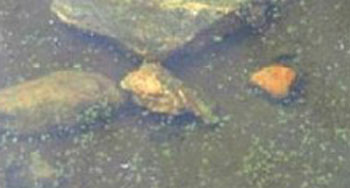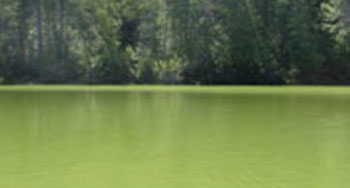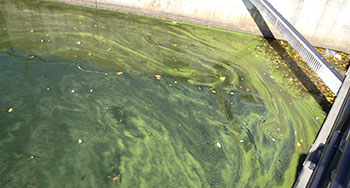
Cyanobacteria
Lachine Canal National Historic Site
What are cyanobacteria?
Cyanobacteria are aquatic microorganisms found naturally in aquatic environments. Their pigmentation can vary from blue-green, olive green, dark green, purple to red. As such, their presence in aquatic ecosystems is normal, but it becomes a problem when they multiply rapidly and form a mass visible to the naked eye on the water surface. This is known as a "bloom." Clusters of substances are then formed on the surface, called "blooms," foam or froth, depending on their intensity.
A number of species of cyanobacteria store natural poisons called cyanotoxins in their cells. These toxins are released into the water when the cell breaks down or dies. Contact with or ingestion of water contaminated with too much cyanotoxin can cause health problems.
Identify cyanobacteria
The algae blooms are most often green or turquoise and depending on their intensity look like:
- Abnormally cloudy water, floating particles or sparse streaks on the surface. The bloom is then of low density, hardly noticeable, and does not necessarily give the impression of a change in the water (category 1)
- A "soup" of particles, similar to pea soup, or filaments that may remind one of thin, short pieces of grass (category 2a)
- A paint spill on the surface or a film on the surface of the water or deposits near the shore (category 2b)



In general, cyanobacteria blooms between May and October.
Conditions for the proliferation of cyanobacteria
Cyanobacteria need light, heat and nutrients to grow. When the conditions are right, they can develop on a massive and rapid scale. Many factors influence this proliferation; therefore, the timing of the bloom cannot be predicted. But some conditions are more favourable:
- Water rich in nutrients (mainly phosporus)
- Stagnant water
- Light intensity
- A sudden warming of the temperature
In general, cyanobacteria blooms between May and October.
Effects of cyanobacteria
Cyanobacteria blooms can have multiple consequences:
Impacts of cyanobacteria on ecosystem health
- ecosystem imbalance
- oxygen depletion
- mass mortality of fish, invertebrates and animals (by ingestion of toxins)
Impact on human and animal health
Exposure to the toxins, by consumption or by direct or indirect contact, can lead to gastro-enteritis and/or liver and kidney disorders. Cases of mortality in wild and domestic animals have been reported following exposure to cyanotoxins.
- Digestive disorders (stomach ache, nausea, vomiting, diarrhea, etc.)
- Neurological disorders (dizziness, headache, malaise, fever, etc.)
- Skin disorders (itching, irritation, redness, etc.)
Symptoms may vary from one individual to another, depending on the concentrations of toxins present and the conditions of exposure (swimming, water sports, ingestion).
Impact on recreational activities
Certain situations may lead to health restrictions on recreational uses.
- banning swimming
- closing access
- limiting practices
Prevention and actions to take
In areas affected by cyanobacteria blooms, it is recommended to:
- Avoid water-based activities that may result in direct contact with cyanobacteria
- Avoid areas with concentrations of blue-green algae
- Keep at least 3 metres away from blooms or foam
- Keep young children away from potentially contaminated areas
- Keep pets on a leash, to avoid access to the affected body of water
- NOT consume any fish caught in the affected body of water
- NOT drink water directly from a contaminated water body
What to do in case of contact with cyanobacteria?
- Avoid touching your face with your hands
- Wash your hands or other affected body parts thoroughly before touching your eyes, face or mouth and before eating, drinking or smoking
- Thoroughly wash any objects or equipment that have come into contact with the contaminated water
If symptoms occur as a result of contact with cyanobacteria, seek medical attention.
- Date modified :